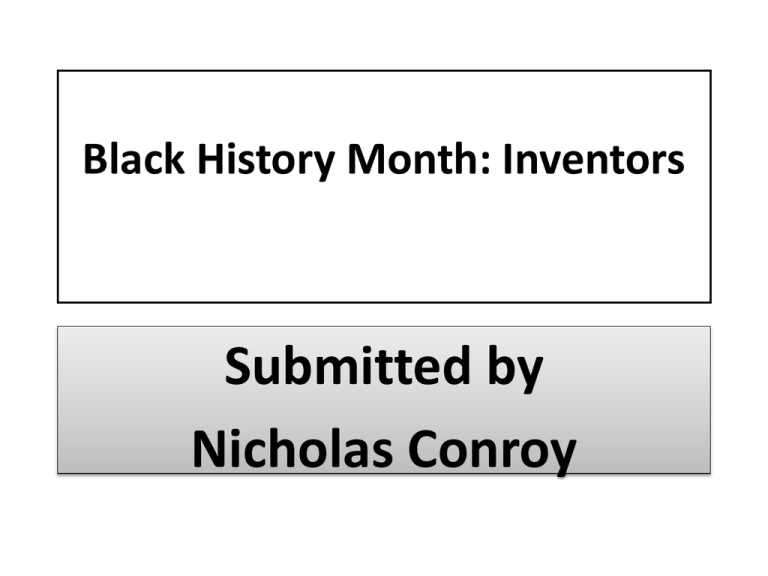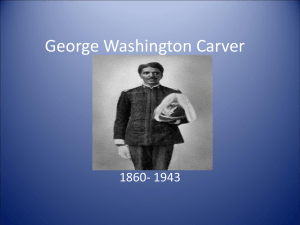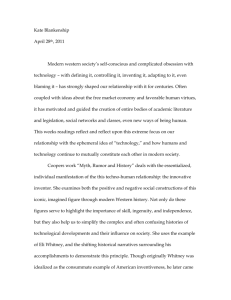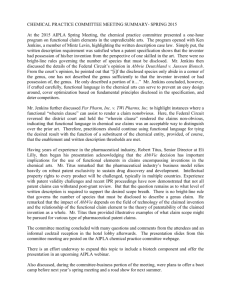Black History Month: Inventors
advertisement

Black History Month: Inventors Submitted by Nicholas Conroy From his laboratory at Tuskegee, Carver developed 325 different uses for peanuts--until then considered lowly food fit for hogs--and 118 products from the sweet potato. Carver did market a few of his peanut products. The Carver Penol Company sold a mixture of creosote and peanuts as a patent medicine for respiratory diseases such as tuberculosis. He is often credited with the invention of Peanut Butter, a claim that has been cited in American schools and educational programs for decades. While he may have made peanut butter during his time studying the peanut, peanut butter has existed since the time of the Aztecs who made it from ground peanuts. Garrett Morgan was born in Paris, Kentucky in 1877. As a selfeducated man, he went on to make an explosive entry into the field of technology. He invented a gas inhalator when he, his brother, and some volunteers were rescuing a group of men caught by an explosion in a smoke-filled tunnel under Lake Erie. Although this rescue earned Morgan a gold medal from the City of Cleveland and the Second International Exposition of Safety and Sanitation in New York, he was unable to market his gas inhalator because of racial prejudice. However, the U.S. Army used his device as gas masks for combat troops during World War I. Today, fire fighters save lives because, by wearing a similar breathing device, they are able to enter burning buildings without harm from smoke or fumes. Also, credited with having a patent for a type of traffic signal, and invented a hair-straightening preparation. Lonnie Johnson In 1989, Johnson formed his own engineering firm and licensed his most famous invention, the Super Soaker water gun, to Larami Corporation. Two years later, the Super Soaker generated over $200 million in retail sales, and became the number one selling toy in America. Larami Corporation was eventually purchased by Hasbro, the second largest toy manufacturer in the world. Over the years, Super Soaker sales have totaled close to one billion dollars. Currently, Johnson holds over 80 patents, with over 20 more pending, and is the author of several publications on spacecraft power systems. Lewis Latimer Lewis was employed as an office boy with a patent law firm, Crosby Halstead and Gould, with a $3.00 per week salary. He learned how to use an L square, ruler, and other tools. Later, after his boss recognized his talent for sketching patent drawings, Latimer was promoted to the position of head draftsman. In 1874, he co patented (with Charles W. Brown) an improved toilet system for railroad cars called the Water Closet for Railroad Cars (U.S. Patent 147,363). In 1876, Alexander Graham Bell employed Latimer, then a draftsman at Bell's patent law firm, to draft the necessary drawings required to receive a patent for Bell's telephone. Latimer received a patent in January 1881 for the "Process of Manufacturing Carbons", an improved method for the production of carbon filaments used in light bulbs. Henry Brown was an inventor, credited with the invention of the first strongbox. Prior to the invention, people often kept personal and valuable papers in simple wooden boxes in their homes or at local banks. These boxes provided no deterrent against burglars or bank staff reading them. He developed a lockable, forged-metal container, divided into compartments, and patented his invention (number 352,036) on November 2, 1886.
![Introduction [max 1 pg]](http://s3.studylib.net/store/data/007168054_1-d63441680c3a2b0b41ae7f89ed2aefb8-300x300.png)










